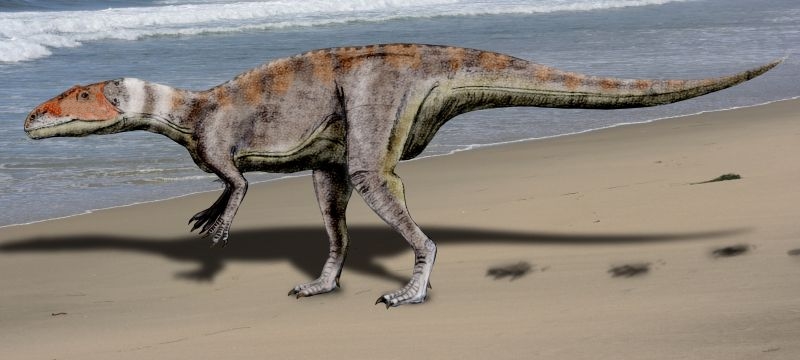Dubreuillosaurus NT on:
[Wikipedia]
[Google]
[Amazon]
''Dubreuillosaurus'' is a
 In 1994, the mayor of Conteville in
In 1994, the mayor of Conteville in
genus
Genus ( plural genera ) is a taxonomic rank used in the biological classification of extant taxon, living and fossil organisms as well as Virus classification#ICTV classification, viruses. In the hierarchy of biological classification, genus com ...
of carnivorous dinosaur
Dinosaurs are a diverse group of reptiles of the clade Dinosauria. They first appeared during the Triassic period, between 243 and 233.23 million years ago (mya), although the exact origin and timing of the evolution of dinosaurs is t ...
from the middle Jurassic Period
The Jurassic ( ) is a geologic period and stratigraphic system that spanned from the end of the Triassic Period million years ago (Mya) to the beginning of the Cretaceous Period, approximately Mya. The Jurassic constitutes the middle period of ...
. It is a megalosaurid
Megalosauridae is a monophyletic family of carnivorous theropod dinosaurs within the group Megalosauroidea. Appearing in the Middle Jurassic, megalosaurids were among the first major radiation of large theropod dinosaurs. They were a relative ...
theropod
Theropoda (; ), whose members are known as theropods, is a dinosaur clade that is characterized by hollow bones and three toes and claws on each limb. Theropods are generally classed as a group of saurischian dinosaurs. They were ancestrally c ...
. Its fossils were found in France
France (), officially the French Republic ( ), is a country primarily located in Western Europe. It also comprises of Overseas France, overseas regions and territories in the Americas and the Atlantic Ocean, Atlantic, Pacific Ocean, Pac ...
. The only named species, ''Dubreuillosaurus valesdunensis'', was originally described as a species of ''Poekilopleuron'', ''Poekilopleuron? valesdunensis'', which is still formally the type species
In zoological nomenclature, a type species (''species typica'') is the species name with which the name of a genus or subgenus is considered to be permanently taxonomically associated, i.e., the species that contains the biological type specimen ...
of the genus. It was later renamed ''Dubreuillosaurus valesdunensis'' when, in 2005, Allain came to the conclusion that it was not part of the genus ''Poekilopleuron''. Its type specimen, MNHN 1998-13, is only rivalled in the number of preserved elements in this group by that of ''Eustreptospondylus
''Eustreptospondylus'' ( ; meaning "true ''Streptospondylus''") is a genus of megalosaurid Theropoda, theropod dinosaur, from the Oxfordian stage of the Late Jurassic period (some time between 163 and 154 million years ago) in southern Eng ...
''. ''Dubreuillosaurus'' is considered to be the sister species of ''Magnosaurus
''Magnosaurus'' (meaning 'large lizard') was a genus of theropod dinosaur from the Middle Jurassic of England. It is based on fragmentary remains and has often been confused with or included in ''Megalosaurus''.
History and taxonomy
In 1923, Fr ...
''. It did not show signs of insular dwarfism even though it was uncovered on an island.
Discovery and naming
 In 1994, the mayor of Conteville in
In 1994, the mayor of Conteville in Normandy
Normandy (; french: link=no, Normandie ; nrf, Normaundie, Nouormandie ; from Old French , plural of ''Normant'', originally from the word for "northman" in several Scandinavian languages) is a geographical and cultural region in Northwestern ...
, André Dubreuil, noted that during land rehabilitation
Land rehabilitation as a part of environmental remediation is the process of returning the land in a given area to some degree of its former state, after some process (industry, natural disasters, etc.) has resulted in its damage. Many projects ...
of the old quarry of ''Pierre de Caen'', dinosaur bones had surfaced. He secured a partial skull and some ribs and notified the Paris ''Muséum national d'Histoire naturelle
The French National Museum of Natural History, known in French as the ' (abbreviation MNHN), is the national natural history museum of France and a ' of higher education part of Sorbonne Universities. The main museum, with four galleries, is loc ...
''. However, professional excavations only started in 1998 when the rock of the collapsed quarry face had already been spread by a bulldozer over a considerable surface. It proved necessary to dig up and sieve many cubic metres of rubble over several years, ultimately salvaging about two thousand bone fragments, varying in size between one and ten centimetres. From these scraps a more complete skeleton had to be reassembled.
In 2002, when this process had not yet been completed, Ronan Allain
{{Short pages monitor